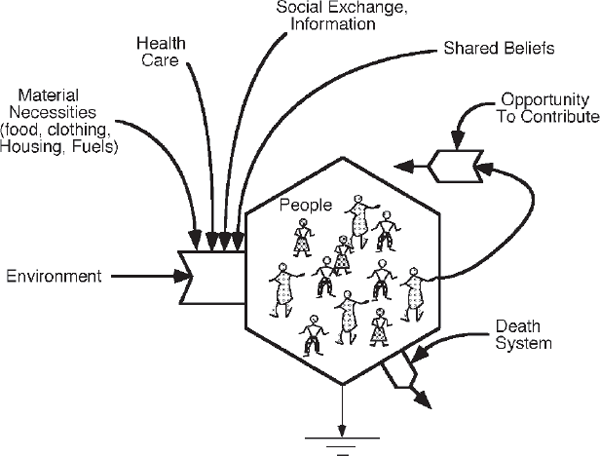
WITH THE ability to learn and cooperate, people occupy the top of the hierarchy of earth energy. Networks of humanity include human biology, individuals, families, populations, occupations, businesses, and governments. People process resources (chapter 7), information (chapter 8), and money (chapter 9). In its structure and functions human society has many similarities with ecosystems. Both require inputs from many scales of the energy hierarchy and feed their work back to reinforce their sources. Figure 10.1 shows some of the necessary pathways for people in order of transformity from left to right. This chapter considers human populations, the organization of human society, and its energy basis.
POPULATIONS
Even though control comes from higher levels of social organization, human society first depends on its population and their life cycle to provide order. The number of people is a balance between reproduction and mortality. In any local area there is also immigration and emigration.
Models of Population Number
Figure 10.2 diagrams some of processes affecting a population in different combinations. Each model includes a typical computer simulation for that design.
In fig. 10.2a there are no energy limits. Population growth is autocatalytic and exponential and can be represented as a constant gain amplifier, with an intrinsic reproductive tendency. In 1798 Thomas Robert Malthus predicted that if reproduction continued at a constant rate per individual, the acceleration would cause the food resources to fail abruptly, and the population would crash as a result of poverty, malnutrition, and disease.1 The exponential growth graph is sometimes called Malthusian growth.
Figure 10.2b is a “wildlife” model of population supported by an inflowing renewable energy source that limits growth. The population draws from a small food reserve that is being renewed by regular energy inflow. Simulation of growth starting with a few individuals may overshoot, causing an oscillatory transient.

FIGURE 10.1 Necessary inputs to people.
In fig. 10.2c energy for growth is unlimited (availability constant), but the population becomes limited by crowding. For example, dense populations of microbes or animals developing in a limited space can accumulate toxic wastes and inhibit reproductive behavior. Mathematically, these interactions increase quadratically (in proportion to the square of the number, kN2). The model is called logistic and levels off.
Crowding accelerates the spread of contagious disease (e.g., the hoof and mouth disease epidemic in Britain in 2001). The very large energy used in modern health care, preventive medicine, and veterinary medicine has raised the threshold of population concentration at which diseases become epidemic, but catastrophic population crashes can result when these measures are interrupted.
The model in fig. 10.2d adjusts reproduction to fit the available energy. Some mechanism senses the available energy. For example, birds reduce the number of eggs laid when food levels are low (Lasswell and Kaplan 1950); rotifers put out fewer eggs when algal concentrations are less (Edmondson 1965). In short, many natural populations in undisturbed systems practice a kind of birth control (Wynne-Edwards 1962) in which reproduction is a function of the energy budget.
Figure 10.2e is a pulsing model that uses a slowly renewed energy source and reproduction stimulated by interactions within the population. When resources are initially abundant, the autocatalytic feedback to increase reproduction is cooperative and quadratic (proportional to the square of the number, kN2). Growth in the United States was quadratic (Von Foerster et al. 1960) after the onset of the fossil fuel–based Industrial Revolution. The simulation in fig. 10.2e pulses, passing rapidly from rapid growth to descent as the immediately available resource is consumed.

FIGURE 10.2 Models relating population growth and maintenance to available energies. (a) Unlimited exponential growth; (b) growth on a storage supplied by steady energy flow; (c) autocatalytic growth on unlimited source with quadratic losses; (d) model with reproductive rate programmed to be proportional to available energy; (e) model of pulsed population growth based on previous accumulation of slowly renewed energy reserves; (f) population growth on a nonrenewable energy reserve with energy of assets used to reduce mortality and inhibit epidemics. Equations for the models follow. Many others were published elsewhere (Odum 1983).
(a) dN/dt = k1N – k2N.
(b) dF/dt = J – k1FN; dN/dt = k2FN – k2N.
(c) dN/dt = k1SN – k2N2.
(d) dN/dt = f(A)k1N – k2N.
(e) See appendix fig. A10.
(f) dN/dt = k1(A/N)N – k2N(1 – k3A) – k4N2(1 – k5A); dF/dt = – k0FNAR; dA/dt = k6NAR + k7AR – k8(A/N)N – k9N(1 – k3A) – k10N2(1 – k4A); R =J/(1 + k11FNAR + k12AR).
The population model in fig. 10.2f has energy pathways to reproduction and two pathways that represent the action of medicine and public health to inhibit death rates. As resources become less available, reproductive rates decrease, and mortality rates increase, including the quadratic pathway representing epidemics. The simulation shows how the shift from population growth to population descent can occur in a short time. A current example is the AIDS epidemic affecting many countries in Africa.
Human Populations
When most of the energy available to society came from agrarian food supplies, reproduction often was curtailed by famine and the diseases that accompany physiological weakness. Now that the energies available to developed societies are in great excess, food has not been limiting in much of the world, and in poorer countries welfare programs help ensure adequate nutrition. As a result, population growth curves have been steep and Malthusian.
Maximum reproduction rate sometimes has been considered the criterion for natural selection’s survival of the fittest (e.g., in Darwin’s early writings). But maximizing reproduction is useful only in the overgrowth stage of early succession. For later stages of organization, resources are diverted from reproduction to develop organization, diversity, information, efficiency, and large-scale needs. This is exemplified in Darwin’s later writing. Lotka’s criterion for fitness (chapter 3) is contributing most to the maximum empower of the system, and this depends on the stage of the growth cycle.
As explained with figure 3.13 and chapter 7, the economy as a whole may be in an energy-controlled pulse that may turn down soon (chapter 13). The big question is whether population reproduction rates will decrease in proportion.
Human demographers found that human reproduction in the last two centuries rarely seemed to be related to locally available resources. While society as a whole was accelerating energy use and development, reproductive rates, even among the poorest, were responding to growth opportunity images. However, in later stages of urban development, people become so involved in occupations and complex interactions that their reproductive energy is diverted away from reproduction. In other words, people may reproduce according to energy availability and the image of growth of their economy, not according to their individual resources. Because our energy supply was still expanding in the final years of the second millennium, it may be that the system of society had an energy sensor operating, which was still indicating unlimited growth because of high levels of cheap fuels on the world markets.
World birth control initiatives now being undertaken lack the automatic energy sensor for quantitative control found in many natural populations. For human society, some regularly calculated statistics on empower input could be used to influence the number of offspring in any year, as suggested in the model in fig. 10.2d. One suggestion is to use educational financing, with reproduction allowed only after resources have been assembled for the education of the new offspring. To make population regulation work in a way that is consistent with democratic principles may require innovations in social institutions.
Any policies or events that bring population down as fast as the resources decline will sustain the present standard of living (emergy per person). See chapter 13.
Human Life Cycle
Millions learn from the study of Shakespeare in school that “all the world’s a stage, and all the men and women merely players” (As You Like It, II, vii, 139). The roles that people play from birth to death are progressive steps in an energy hierarchy (fig. 10.3a). While territory of support and influence gradually increase, the number of people reaching each stage of experience and education decreases. Notice the behavioral functions that appear with age that are superseded by larger-scale roles at later stages (fig. 10.3b). After learning about food and waste processing, there is elementary education and making friends, followed by passion about sex, and learning an occupation before beginning a later life stage of net societal contribution.
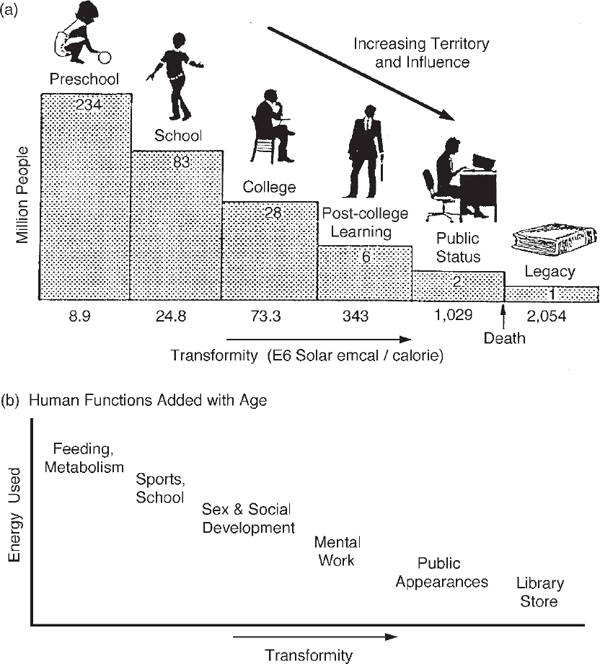
FIGURE 10.3 Life cycle of human beings passing through the hierarchy of age and experience. (a) Distribution of population of the United States by stage, age, and transformity; (b) stages in the human life cycle in which functions of higher transformity are added.
Transformity of people and their main interactions with society also increase with age. The emergy contribution of a person at each stage may be estimated by the energy metabolism multiplied by the hours of effort times the transformity of the person’s level of education and experience from fig. 10.3a.
Health Care
The public health and health care sector of society consists of doctors, nurses, and other health care workers, hospitals, and health maintenance organizations (fig. 10.4). The costs are borne by a mosaic of sources: charges to patients, health insurance, payments from employers to insurers, and appropriations based on taxes from local, state, and federal government. The energy and monetary costs of keeping a population healthy have risen because the populations are larger, their interpersonal exposures have increased, the age of the population has increased (more maintenance required with age), new progress with complex and costly medical technology, new drugs, increasing number of people with birth defects kept alive, rising expectation for care and length of life, and capture of health institutions by for-profit capitalism.
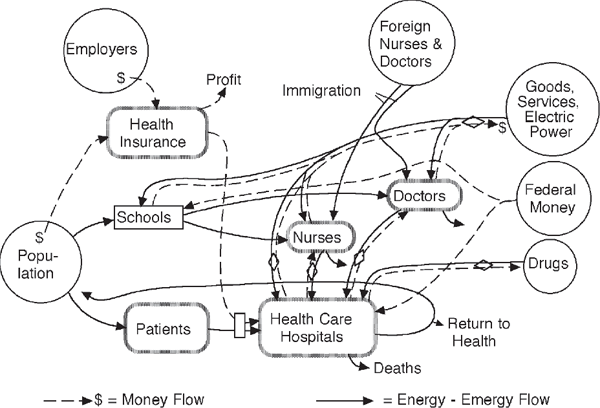
FIGURE 10.4 Model of the U.S. health maintenance system, modified from Logan (1998) (heat sinks omitted).
Institutions that provide regular services can be government owned, private profit, or private nonprofit. From chapter 9, recall that profit making is appropriate where there are unused resources that can support expanding development. Efficiency of return on cost is sacrificed to accelerate growth. But once established, health maintenance systems could sacrifice profit for efficient service. Recently, there was an international struggle over the balance between profit and efficiency in health care. Although sometimes justified as the means for research, profit tends to become the unearned income of stockholders. Charging an extra percentage of cost to pay for medical and drug research without profit might make more sense.
The Future of Health Care in the United States2
The current system of health care in the United States is one of entrepreneurship. Although federal funding and support of the health care system have steadily increased over the past 50 years, the drivers of the system still consist primarily of profit-making entities such as insurance companies, hospitals, and physicians. The profit-making motivation of these key entities drives the system to encourage growth in treatment and cost, whether it is warranted or not.
A simulation model of these aspects of the health care system in fig. 10.4 (Logan 1998) reinforces the idea that continuation of the current system over the long term will result in a rapid growth pattern in treatment rates and costs. The model suggests that the greatest inflation will be in the growth of insurance capital reserves and insurance company profits, perhaps because of the position of the insurance industry as an intermediary, where it is first to receive inflows of financial resources that allows it to siphon off profits easily. The model also suggests a large drain on the financial resources attached to hospitals, perhaps because of their inferior position in the system in relation to inflows.
Simulation results of this model suggested that the introduction of managed care, in which physicians and hospitals may receive incentives not to treat patients, resulted in no substantive decrease in the rate of health care inflation. These results have been supported in the last five years. Health care inflation slowed down briefly during the 2 years after President Clinton’s attempt at health care reform in 1994 but has since escalated again; it is currently running at approximately 6% (Altman and Levitt 2002). This pace cannot continue, given the limits to growth suggested previously (chapter 7).
Unfortunately, the crowded policy arena for health care currently consists of a very diverse number of organizations and entities who compete heavily. This large number of competitors tends to result in the inability of legislators to effect anything but very small, incremental change in the system. Medicare allowed older adults to receive federal benefits that approximate universal health care; recently children have also been included in state initiatives that provide federal support. But the majority of people either have insurance-funded health care or are uninsured. Repeated efforts at major health care reform, including the last attempt in 1994, have resulted in failure.
To be successful now and in the future, health policy must address three issues—cost, quality, and access—before some significant change in the system brings catastrophe. Perhaps the future will include a dramatic increase in demand, as might be caused by a plague or bioterrorism that will make radical reform of the health system necessary. Without reform, the present rapidly growing system may overshoot, causing its eventual collapse. The incrementally advancing federal coverage of patients at both ends of the age spectrum may soften the degree of the overshoot. One can only hope that when the need for reform comes, the United States can adapt gracefully and improve on models from other countries using socialized health care or universal coverage.
A better health care system would include more funding for wellness and preventive care and less emphasis on tertiary care. Health disparities based on gender and race would be absent. The financial incentives that drive the current system would be removed. Treatment of patients would be based on relative outcomes rather than profit incentives. Computerized guidelines for each disease process and treatment would streamline care and provide efficiency. There would be a greater focus on public health and more attention given to aggregate community health outcomes. Financial incentives to teaching hospitals to expand graduate medical education would be reduced to slow growth of the physician supply. Financial incentives to other health care professions such as nursing would be expanded to accommodate growth in population with less costly alternatives to the highly educated physician. This would also allow for a multidisciplinary collaborative approach to patient care and would give the patient more autonomy to become the decision maker for the health care team.
Age and Replacement in Ecosystems
Healthy ecosystems have mechanisms for removing the living parts when they begin to falter because of the depreciation of structure and information. Thus the plankton of the sea and the antelope of the plains both are consumed by carnivores, resulting in the recycling of minerals back into the system, which sustains production. For many populations of animals, the next level of carnivores provides a death system that is programmed so as to help maintain the genetic quality and appropriate distributions and density of the prey population (fig. 8.9).
Slobodkin and Richman (1965) brought plankton into the laboratory without carnivores and found symptoms of individual senescence and lower production, privations that would be selected against in the natural environment. The energy required to maintain an effective population is the energy required to support the carnivores. The energy of the units selected against and eaten supports the quality-choosing function (fig. 8.9).
When carnivores or diseases are exerting control of age distribution, they are doing work beneficial to their prey populations as well as drawing energy from them. This is not so different from farmers selecting as they manage their cattle. Thus, the energy diagram in fig. 7.4 showed a reinforcing loop from humans in managing the cattle.
Genetic Depreciation
With billions of dollars spent for human medicine each year, society in the late 20th century appeared to be removing the extra duplication, selection, and system reinforcement that used to eliminate genetic errors and encourage evolutionary progress. Brilliant medical achievements are directed toward saving all offspring, thus eliminating the quality selection process. As the genetic errors are retained, medicine steps in with ever-greater programs and power requirements to repair, support, and permit the errors to continue to the next generations. Each generation needs more emergy because of the accumulation of genetic errors and losses of function.
Deaths
Human beings, like other tightly organized, concentrated structural storages, reach a stage of deterioration as they age. In aging, the requirements for repair and health maintenance are greater than those for replacement (chapter 8). At an earlier time, the human death system used parasites and diseases that could neatly and cleanly remove people when general deterioration brought the energy reserves of the body below certain minima.3 Many bodies had weak structures in hearts or kidneys that failed long before the rest of the body had deteriorated. This older death system removed weakened individuals, and epidemic disease dispersed populations just as carnivores do in ecosystems. The diseases provided an automatic energy test of the strength to continue life with the medical help of society then available.
But in two centuries of high emergy availability, the global religious–medical ethic has become committed to using all resources possible to preserve life. Medicine and science have greatly restricted the disease method of death without providing a substitute that is humane for individuals. As a consequence of high-emergy medicine, the old, too-efficient death system has been removed. People live longer but often last until they die in misery of cancer or after years of incapacitated immobility, with regret.
Emergy and Health Management Alternatives
Emergy evaluation of health maintenance alternatives can help make health management choices now and in times of less emergy ahead. Currently less emergy now goes into reproduction to replace early deaths, and more emergy goes into medical maintenance. The longer people live, the higher the emergy and monetary costs of medical maintenance. Eliminating the disease control system produced a global population explosion. As a result, we are forced to use more emergy to control births.
There are advantages of older adults to society as long as they can contribute. With the increasing complexity of the power-rich networks, the human computer (educated brain) becomes ever more valuable, with greater and greater empower investments in its training and memory storages. Now individuals begin to be truly unique because combinations of knowledge and training allow them to do things no one has ever done before or may ever do again. The value of individuals who have received large educational investments is vast, but perhaps emergy should not be used to sustain people in vegetative states.
We might wonder whether disease and subsequent death served primitive people well, both for individual lives and for the effectiveness of their role in the system. Is one way any more humanitarian than another, or does it have any energetic advantage? When there is retrenchment of the rich energy sources, the old system may return with a vengeance. Do epidemics and hardships for the handicapped follow? Primitive, disease-resistant human stocks may be available from countries where there has been more natural selection in recent years.
ORGANIZATION AND GOVERNANCE
Social relationships make society an organized structure of cooperative functions instead of a crowded mob. Organized social systems displace those that seek to disorganize, such as anarchy. On each scale, from the family to global society, there are groups of people who support and are led by a more important but smaller leadership group operating at the next larger scale (fig. 10.5). A family has children led by the parents. The military organization has designated ratios of soldiers, corporals, sergeants, lieutenants, captains, majors, colonels, and generals in which transformity increases and numbers decrease with rank. Human organization appears to follow principles of energy hierarchy (chapter 4). Other studies have examined political organization as a system and diagrammed pathways of political power (Lasswell and Kaplan 1950). Here they are given their position in the energy hierarchy (figs. 10.5 through 10.8).
Human decisions open and close the main empower flows of the economy and environment. Control networks exist in mental concepts and relationships, learned and accepted by individuals to guide their behavior. Through votes on committees, acceptance of authority, participation in elections, and other control mechanisms, humans ensure continued flows of their own emergy and that of their institutions. Figure 10.5 shows the general form of the loops of reinforcement in hierarchies of government.4
Successful management in industry has a cascade of control spreading out for decentralized action. Top management has high transformity and the empower to direct a few large-scale functions, but the main volume of decisions and energy transformation is decentralized in steps down to the leaders of small groups.
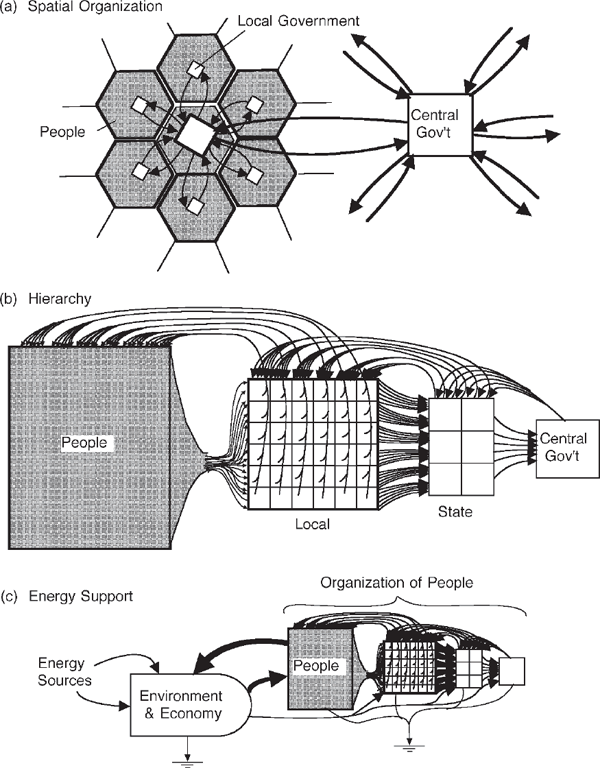
FIGURE 10.5 Superstructure of human social organization that operates environment and economy. (a) Spatial convergence and divergence; (b) people and units of government arranged left to right in order of transformity; (c) energy basis for social organization.
Empower concentration is necessary for large-scale actions, but most of the decisions and controls are small scale and are relegated to the smaller units of government and individual decisions. We call the distribution of power control at many levels democracy. Thus, emergy-based hierarchical organization resolves the old argument about which society is best, the highly centralized or the entirely decentralized.
Law
As systems become older and complex, relationships can be coded as laws, which are society’s means of maintaining a workable network. In systems models, a law is a control pathway, often turning actions on or off.
Using Hohfeld’s theory of dynamic law, Hoebel (1961) examined primitive cultures for the rudiments of law. Four types of interpersonal relationships of the Hohfeldian system were used for eight basic relationships. In systems diagrams rights are information pathways that control function.5 The demand right of one person to draw a duty from another is an energy circuit in which the downstream recipient may elicit some upstream work, but the upstream unit may not interrupt the flow.
The privilege right of one person to operate without a demand right from the other is an energy flow without connection from the other. It is an insulated relationship only the privileged may change with switching action.
A power individual may generate a work flow involving a liable individual with or without a contract for return exchange. The liable individual may form a flow only with the switching action of the power individual.
The immunity of a unit to any power flow from another unit affecting it means that the immune unit has the right to remain insulated, without a network connection.
Whereas smaller groups can be organized with personal relationships, it took the innovation of written law and enforcement to make larger groups stable.
Spread of Innovation
The spread of innovations in society is like biological evolution but much more flexible. Toynbee’s ideas (1935–1939) about the sequence of innovation are diagrammed in fig. 10.6. Various relationships are tried in the self-organization process of many groups on a small scale. An innovation that reinforces production and increases empower prevails, and that system expands, capturing more emergy. Then the information regarding that innovation spreads to other areas, and the advantage of the early monopoly is lost. The dominant system loses its supremacy, and the advance becomes general. Innovations sometimes spread gradually and peacefully; at other times, change is resisted, as with civil war.
Roman Empire
Historians often cite the innovative system of laws, slaves, and military legions that sustained organization in the Roman empire. It was the greatest world order ever built on solar energy alone. Figure 10.7 is a highly aggregated diagram of the Roman system. With innovations in organization, military mechanisms, and government service, a reinforcing loop directed enough emergy into organizational work to produce innovative culture, structures, and institutions. Whereas money was used in smaller transactions, grain and slave levies were exchanged on a larger scale and enforced by the Roman legions. The people of Rome were fed with grain levies from provinces such as Africa, whereas other provinces contributed slaves, recruits for the legions, manufactured goods, and literary services. The feedback of organizational services to the provinces generated support for Roman authority. The high-transformity military work of the legions was supported by the conquered lands. The legions prevented the surrounding tribes from draining energies from the main Roman provinces for several centuries.
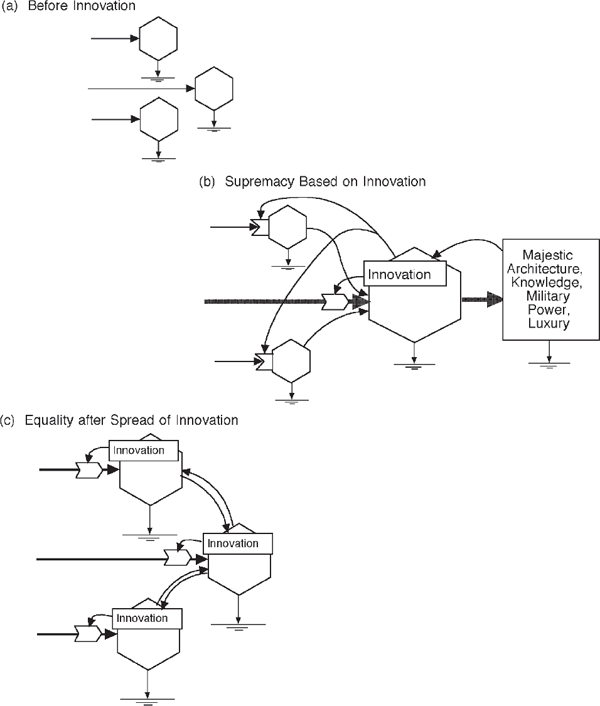
FIGURE 10.6 Systems view of the spread of innovation, after Toynbee (1935–1939). (a) Isolated units with low empower; (b) monopoly with a new innovation draws high empower and control of other units; (c) spread of the innovation equalizes empower support.
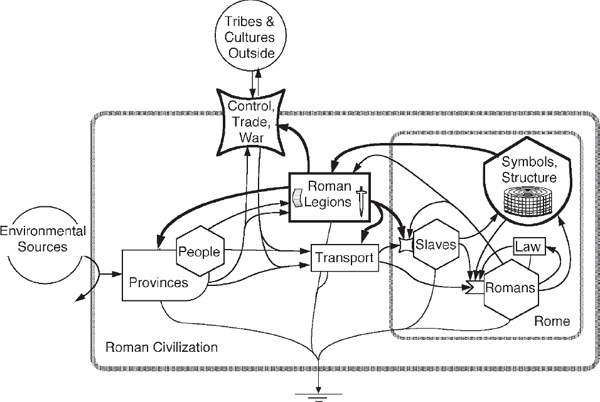
FIGURE 10.7 Systems diagram of the Roman Empire.
The fall of the Roman Empire fascinates historians and scientists. Consider how some factors (Gibbon 1962) could have reduced pathway reinforcement on the energy diagram. Strength of discipline in the Roman legions was weakened by loss of a common image of invincible loyalty. The central government was weakened by the competing hierarchy of Christianity, and as Christian rule became absolute, it eliminated polytheism and the information associated with it (the great library at Alexandria). A shift in rainfall belts may have reduced the grain production of North Africa, diminishing the emergy support for Rome, the center of power. A contributing mechanism was the loss of monopoly on innovations (Toynbee’s theory in fig. 10.6). If part of the early Roman success was based on their innovations, the spread of this knowledge might have allowed surrounding provinces to organize and begin to take some lateral energy flow formerly directed toward Rome. An emergy evaluation of the invasions of Rome is needed, similar to the one done by Bob Woithe (1994) for the U.S. Civil War.
Organization of Two Units
After interacting to test relationships, two competitive individuals can adopt a plan of work sharing with mutually reinforcing loops, shown in fig. 10.8a. This simple organization eliminates competition, conserves energies, and is able to evolve because the two units help each other and together do more. The design applies to many relationships, such as love, marriage, partnership, contract, symbiosis, and business partnership. Primitive examples are the pecking-order relationships among chickens that become organized after a learning period (Allee 1938, 1951). Berne (1964) used a special language of two-way vectors to show types of psychological organization between two individuals.
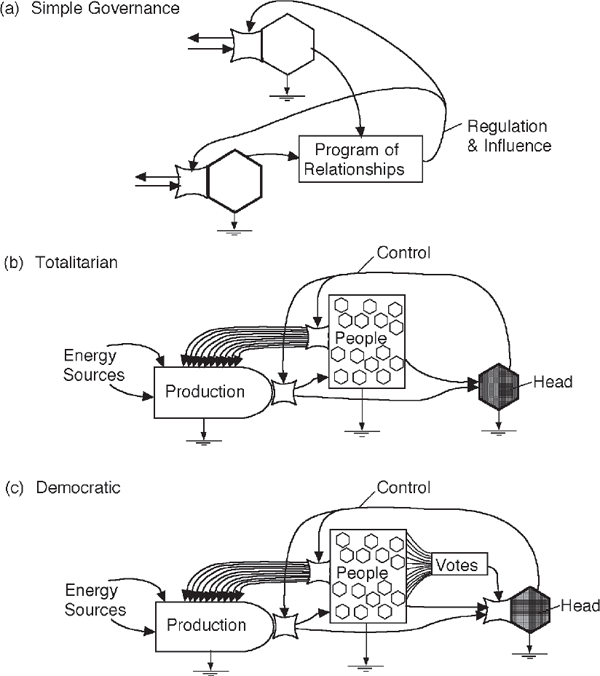
FIGURE 10.8 Diagrams of the flows of energy convergence and control loops for different forms of government.
Types of Governments
Government is a group’s system of control and public services. It is a sharing of information that makes a society of people follow its organization pattern. The design in fig. 10.8a for symbiosis of two individuals is a simple government.
Figure 10.8b is a totalitarian design between a head and its supporting group. Lower-level people supply products and services that are controlled by the “head.” The products may be diverted from the work and welfare of the people. There is no automatic mechanism to keep the top level efficient in reinforcing the group or its production. Examples are slaves and owners, class control by an aristocracy, government by inherited royalty, theocracy or government by religious authority, and military dictatorships. Without some way to ensure that actions of the head are reinforcing, the system is not self-correcting, and revolutions may occur.
Figure 10.8c demonstrates a more democratic design in which the head is controlled by votes of the majority. Votes can reinforce the controls that work. Empower converges to the head but is distributed out to the group in services. Democracy is an innovation in which control is mutual, passing up and down the hierarchy. Elections and replacement of leaders allow change according to the society’s collective image of performance. Systems with individual rights prevail, and the freedom improves the productive performance of the people.
Political “left” and “right” refer to the left and right ends of the political hierarchy (fig. 10.8c). Many people of smaller individual empower on the left support and are controlled by a few of high transformity and influence on the right. The social hierarchy is analogous to the food chain hierarchy of ecosystems and is energetically similar (Odum and Scienceman 1986).
Social Structure and Political Power
The influence of individuals, groups, and political bodies lies in the useful potential energies that flow under their control. Political power does work, gains and manipulates storages of energy, and directs forces. The energetic laws are as much first principles of political science as they are first principles of any other process on Earth. Control is measured by transformity and empower. We can clarify many of the political, military, and international problems of our times by evaluating them in empower units. A government that prevails controls the most empower.
Social animals and humans, through their programs of information transfer and response to each other’s information, exert controls and influences on each other’s work. Transmissions of opinions are adaptive and produce social structure and actions. In psychological studies, social power and force have long been recognized and described with factors and matrices of different combinations of interaction (Cartwright 1959). Concepts include resistances to forces, opposing forces, and interactions, which have their counterparts in the physical and biological systems. Measures of correlation, frequency, and probability have been used to indicate pathway strength (French 1956). Using energy systems diagrams and emergy evaluation for these pathways unites physical, biological, and social concepts of power.
CLIMAX SOCIETY
Societies of developed nations are becoming mature and diverse. Sequences of human history are like ecological succession. Competition, overgrowth, and simplicity in times of growth are followed by a climax stage of accumulated assets and diversity. Later there is descent. In the mature stage units and functions are complex and interconnected. Figure 10.9 shows similarities between the diversity of species and the occupational diversity of society.
Chapter 8 (fig. 8.10) explains that more energy is required for organizing diversity, but the consequence is also greater efficiency in converting energy inputs into production. Sometimes the greater energy required for organization is said to be an inefficiency and is called Parkinson’s law. However, organizational energy is a necessity for organizing work that cannot be done by individual parts; we may accept a small power diversion as necessary. The animals in a forest or a sea use energies in their behavioral interactions to perform certain activities in unison. Fishes school, birds divide up a food area by zoning themselves in territories, and insects divide up the feeding times, with some operating at night and some during the day. In forests, the larger hawks and the migrating flocks of animals and birds compose a weak government, integrating the energy flows, cropping excesses wherever they tend to develop, and redistributing the minerals involved in their waste dispositions. In organized society, 20–50% of each citizen’s dollar budget goes into supporting the government.
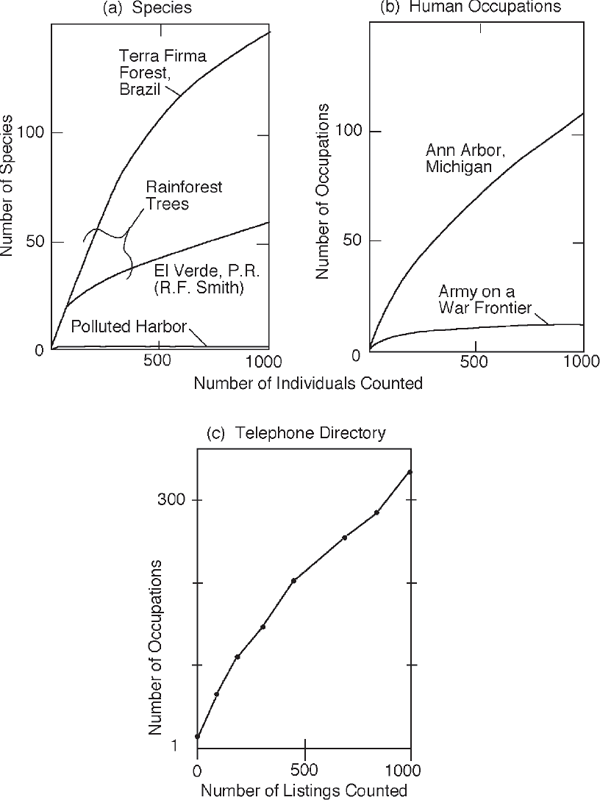
FIGURE 10.9 Comparison of species diversity and occupational·diversity. (a) Species–individual curves for ecosystems; (b) occupation–individual curves for human occupations in Ann Arbor, Michigan, in 1964 (Clark et al. 1964); (c) occupational listing curve for human business in a telephone directory in Gainesville, Florida, in 1999 (Odum 1999).
Where little energy is available, there is little energy for complex organization because there is hardly enough for individuals. Centralization of power and individual freedom in using energy were rarely possible before 1800. Humans were able to organize large areas of the world only when large excess fuel inputs became available for integrating systems of communication, government organization, and military outlays.
Images of Public Belief and Motivation
Part of the social nature of human beings as they have evolved so far is the exchange of information by which a consensus of attitudes toward their own collective society is taught, shared, and dramatized with such symbols as flags. Figure 10.10 summarizes the emergy-based social hierarchy supporting Asian societies. The dragon symbolizes the unity and power of society that is celebrated with fireworks at festival time. In some countries there are military parades; in others there are parades of commerce and customers celebrating an image of consumer power.
Competition and Sports Extravaganzas
Sports are a part of most cultures, with many useful functions: maintaining healthy physiques, teaching how to improve performance through competition, and teaching social cooperation toward group goals. These benefits are important in the education of the young.
As systems of society pass through stages of succession into complex mature stages, sports achieve a central importance to the people who share and revel in public games as spectators. Sports arenas are found in the Mayan ruins, in the stadiums of ancient Rome, and increasingly in the priorities of budgets and time of developed nations. Sports winners become national heroes and highly paid celebrities. Sports events and images become a way for people of greatly different cultures and backgrounds to share common discourse. Integration of sports in the southern United States was a major force accelerating racial integration after World War II.
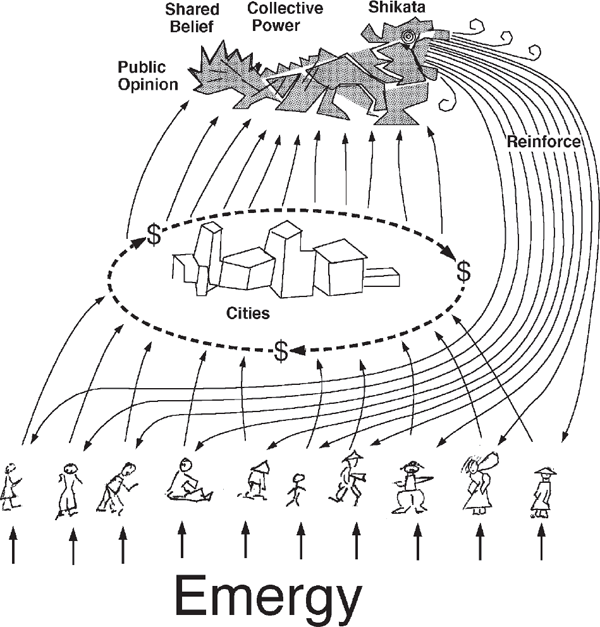
FIGURE 10.10 Society and its shared images of unified power, symbolized by the dragon.
The nature of the sports system in the mature society is suggested in fig. 10.11. The sketch shows the spatial hierarchy of converging input and diverging aftereffects as people assemble and disperse. It is an information-sharing phenomenon that appears to reinforce social cohesion. It provides a fairly harmless outlet for some of the competitive behavior that is not needed when society is in its complex mature stage. Championships, Olympic games, and Superbowls are high-level storms of society that absorb the group focus and fanatic attention that might otherwise go into destructive competition and war. In the highly energized society of the developed world, sports generate social eddies analogous to the turbulent swirl of fluids in stormy seas. Repeated pulses of excess energy may generate a natural selection of designs that improve empower on the average (chapter 4).
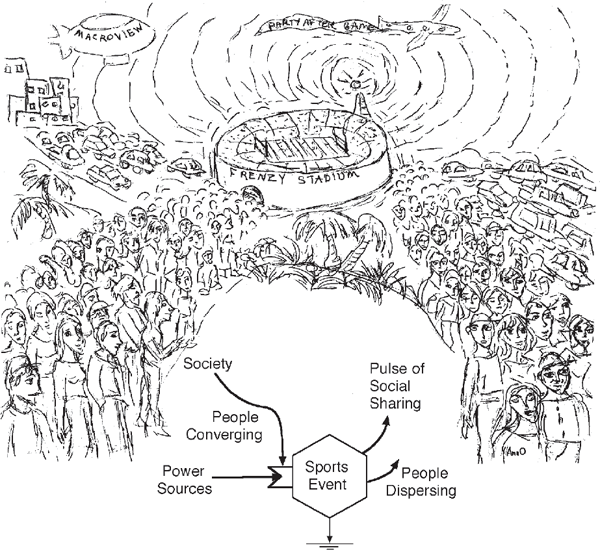
FIGURE 10.11 The system of high-emergy sports extravaganza, a pulsing surge of social sharing (Ann Odum).
Within our present consumer society organized by a market economy, commercial advertising has been coupled to the sports system, causing extraordinary money to go to television sports advertising and celebrity salaries. Clearly there is pathology when entertainment enterprises take more money and emergy than necessary away from the more essential tasks of making everyone adequately educated and employed to contribute to basic production. Sports heroes are a new kind of aristocracy. Some of these celebrities are beginning to feed their wealth back to society as a form of noblesse oblige.
Emergy Diversion and Destruction
When work is done by one process on another in productive interactions, large amplification factors are important if the first is to control the second. When the work operation is one of disordering the other system, it is operating in the direction of the natural tendency for disordering and dispersion of the second energy law. Less potential energy is required to disorder than to order. An illustration of this is the role of light energy in plants in two processes: photosynthesis, in which light builds up structure, and photorespiration, in which light captured by rhodopsin is harnessed to help the disordering of respiration.6 Kowallik (1967) found much less energy required for disordering than for reordering.
In the high-emergy developed world, resources are easily diverted from the useful pathways into endeavors that appear to be destructive. Diversion of emergy from useful pathways by crime is analogous to the short circuits of electrical systems. To prevent losses, insulation is used in electric systems and hot air ducts to keep energy in useful pathways. In society, police institutions and crime prevention are analogous to preventive insulation and are observed to increase with energy levels. As the emergy within societies increases, it takes more emergy for police to counter the destruction by criminals and terrorists.
High-transformity pulses have great destructive power when applied to disorder high-emergy structural storages. Helping available energies to disperse more rapidly creates momentary and destructive autocatalytic storms. However, destruction often is used by one system to replace another. Whenever disordering is adaptive, it is cheap. For example, explosives have great effect in removing city buildings during urban renewal before reconstruction. Civil revolutions are examples on a larger scale. By using destructive means, terrorism allows a few people with high-transformity weapons and motivation to have major effects on society as they set off secondary physical and social eddies. Whether destruction is useful depends on its effect on the social empower examined on the larger scale of time and space.
Uncoupled Energy and Social Eddies
Like murder, so the expression goes, energy will out. A flow of energy either goes into storage or drives processes. If it goes into storage, it builds up its ability to drive more processes in that place. If a flow of energy does not do useful work and does not have feedback loop controls, that energy flow may do work that is detrimental and explosive. Laws of energetics limit not only the nature of useful work but also our ability to discard potential energy quietly.
In electrical systems, short circuits are flows of energy not harnessed to useful work. Instead, the rapid dispersion of energy into heat forms heat gradients and does detrimental work such as melting the insulation of wires. There is deafening noise, clouds of steam, and managerial confusion when an electric power plant is suddenly disconnected from the load of its powerlines. In forest fires, sudden release of heat develops strong thermal winds, a pattern that is similar to river systems in which a waterfall throws its potential energies into geological work on the riverbed. In all of these examples, the proffering of potential energy leads to dispersive processes that also do work as they shunt away energy. Available energy cannot be released without doing work. Hence, any design or energy network must provide a controlled and useful channel for the energies supplied or the system will find its own circuit, one that may be inimical to society.
In social systems in the 1980s, money was given for welfare support of idle youth, for the unemployed, and in other arrangements, without coupling the people aided to useful work. Then, as in the short circuit or the forest fire, the energy emerged in useless social eddies, additional reproduction, group agitation, disorganized play, theft, and paramilitary adventures.
In natural pine forests, fire is part of the stable system as long as it is regular, helps release minerals, and restarts the succession of tender plants. Social eddies can become part of a stable system if they are regular and serve some useful feedback-reinforcing functions. Simple war and energy-using defense games may have shunted excess energy in the past (e.g., fig. 7.1). If means for the regular use of excess energy storages are not provided, they may accumulate until fire, explosion, or social disorder is so great that it is destructive to the whole system. The elimination of fire from pinewoods sets the stage for disastrous fires 20 years later. Eliminating energy outlets from energy-rich economies may cause the buildup of a potential for greater damage at a later time.
Learning Pathology and Addiction
The spread of human society as the world’s information processor evolved with the great learning capacity of the human brain. Patterns of information processing that generate useful functions are rewarded with neurochemical reinforcement that establishes pathways in memory for frequent reuse. Thus people store information as they learn useful functions, including those within the body and the behavioral interactions that are reinforced by society.7 Addictive drugs are chemicals that steal and divert learning mechanisms and attention by reinforcing pleasure pathways and priorities for more drug use and access. The addictive drugs are another case of energized destruction.
Use of illicit drugs has reached extremes in developed society, diverting emergy, corrupting governments, overloading the prison system, and fostering disrespect for government. Most people acknowledge that such habit-forming drugs as tobacco, alcohol, marijuana, heroin, cocaine, and many others are destructive. These are high-transformity substances with great amplifier impact on neurobiological learning systems. Most agree that becoming addicted often ruins health, causes financial ruin, destroys social relationships, and stimulates crime. It may be that as society moves from the simple focus on growth to the complexity of climax, many people lose motivation, making them drug susceptible.
Society has vacillated in its approach to drug use. With addictive alcohol, society has sometimes prohibited sales, sometimes legalized alcohol, and at other times limited the times and places of use. Legalizing drugs may make it easier for the young to become addicted, but money can go for education and treatment. Making the drugs illegal leads to huge black markets, with international smuggling and incomes as great as the budgets of governments. The underground economy and the economy of drug enforcement have become major parts of the economy of many nations. Production, distribution, and consumption of addictive drugs have increased with energy use, global transportation, and excess wealth in developed countries. Addictive drug use may be expected to diminish in a lower-emergy world.
Whenever something destructive becomes important, one needs to look to the larger scale to see what it may be reinforcing. The flow of drug money from developed to undeveloped areas may be one of the ways in which global self-organization is equalizing emergy exchange. For example, the emergy that can be purchased with drug money returning to Colombia may exceed the emergy in the cocaine transfer to the United States.
INTERNATIONAL EMPOWER
Society on the global scale is a family of self-organizing states and nations. Each society is controlled by the global earth processes, the international circulation of money, the shared genetics of humanity, and the ideas and ethics of international behavior learned and globally shared. By the end of the second millennium the explosive wave of development of the Industrial Revolution culminating in the information revolution was uneven, with great differences in population, empower, and emergy storage. Table 10.1 compares indices of the nations.
Unequal Exchange
As explained with fig. 9.15, each country has a different emergy/money ratio, which determines how much of its real wealth goes abroad with trade and fiscal exchanges. Included in table 10.1 is the ratio of emergy received to emergy given in international trade. In the recent past, populations reproduced faster in the undeveloped countries and migrated to the developed nations, representing an emergy drain from the country left behind. In addition, resources from the undeveloped country often were exported to the developed nations, where they stimulated the economy. The combination of the “brain drain” and exports of resources often left the undeveloped country impoverished.
The accumulation of high emergy in developed countries allowed the capital that was accumulated there to be directed in ways that autocatalytically drained the other countries. This was done with the help of colonial military invasions in the 19th century and with economic imperialism in the 20th century. It was fostered by the belief that price measures real value and that loaning money is a benefit to less developed areas.
Organizations at great distance from their source of control develop tensions if the reinforcement loop between the people and distant governance fails. For example, in the early American colonies, self-organization on the frontier reinforced local needs, whereas the English Crown tried to sustain the inequitable exchange of empower favoring British needs in its trade with the colonies. Thus two feedback loops were competing for control, one for local benefit and one by and for the governing parent. Protests such as the Boston tea party started the American Revolution. In the subsequent empower testing of war, there was enough empower in the 13 colonies, supplemented with empower aid from the French, to overcome the empower that Britain could transfer easily across the ocean. In 1864, during the American Civil War, the empower of the northern states eventually exceeded that of the south (Woithe 1994).
TABLE 10.1 National Emergy Indices
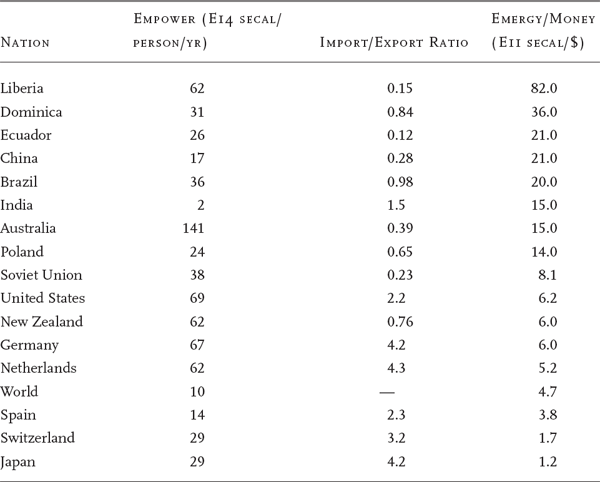
Note: Based on tables 10.7, 10.8, and 11.1 in Environmental Accounting (Odum 1996). The indices are from national evaluations from different years between 1986 and 2000.
Relationships of Nations
At the global scale, nations have some of the properties of businesses competing in an economy or species in an ecosystem. Minimodels of some parallel relationships are shown in fig. 10.12. Simple competition for resources (fig. 10.12a) and active competition with war (fig. 10.12b) prevail when energy use is expanding. Competitive exclusion occurs because overgrowth of the more rapid colonizers maximizes empower at that stage. Later, when few unused resources remain, trade and specialization develop (fig. 10.12c), which makes the two units cooperatively coexistent.
Military Controls and War
In war, disordering disrupts the military systems, and much damage is accomplished with high-transformity weapons. Perhaps the prevalence of war in some earlier systems for such purposes as territorial organization and renewal was useful. Now, however, with vast new quantities of energy injected into war programs, the system has shifted to one of waste. A war zone develops a high emergy flow because it receives the emergy from both systems for competition and for control. Emergy evaluation was made of several wars.8
A forest edge is another high-emergy boundary and is a zone of conflict. It has more birds that enforce territories and use the emergy of both forests and fields. Some complex ecological systems that are adaptable and resilient have ecosystem soldiers. These are specialists whose biological behavior is programmed to destroy the outside agents that are dangerous to the parent ecosystem. The kelp beds of the sea raise kelp bass, which are programmed to concentrate on urchins that would otherwise cut the kelp and float it away. McClanahan (1990) showed that East African coral reefs had triggerfish regulating the urchins. After the triggerfish were overfished, urchins destroyed reef complexity. Similarly, the fishes of tropical reefs graze back turtle grass in the vicinity of corals, thereby preserving the reef.
Behavior is a mechanism for self-organizing. Some human behavior makes sense only at the system level. Ardrey (1966) recounted the behavior programs of animals and people distributing themselves over the land. Before the fossil fuel era, “the territorial imperative,” as Ardrey called it, distributed human populations evenly in relation to the energy incoming from the sun, which was roughly proportional to area. Now, however, the new extra energies of fossil fuel are not coming in on an area basis but are available at any place that can receive a tanker.
The ability of nations to incorporate new power and transform that power into military power has grown along with other structuring skills. In earlier times of low energy, wars helped expand organizations. For tribes engaged in border conflicts, the wars helped maintain territories, achieving a division of the resources, which was a form of spatial organization. When these wars were decisive so that one group came under the control of another, an organizational structure of greater dimension was imposed. War at this stage channeled emergy into organization.
In the late 20th century, international agencies and peace forces emerged, using police and peacekeeping actions and education to control conflict. Emergy evaluation is needed to determine which system results in higher empower and which takes more emergy to support: a world of decentralized power politics with boundaries established by defense or a world with boundaries maintained by unified international enforcement.
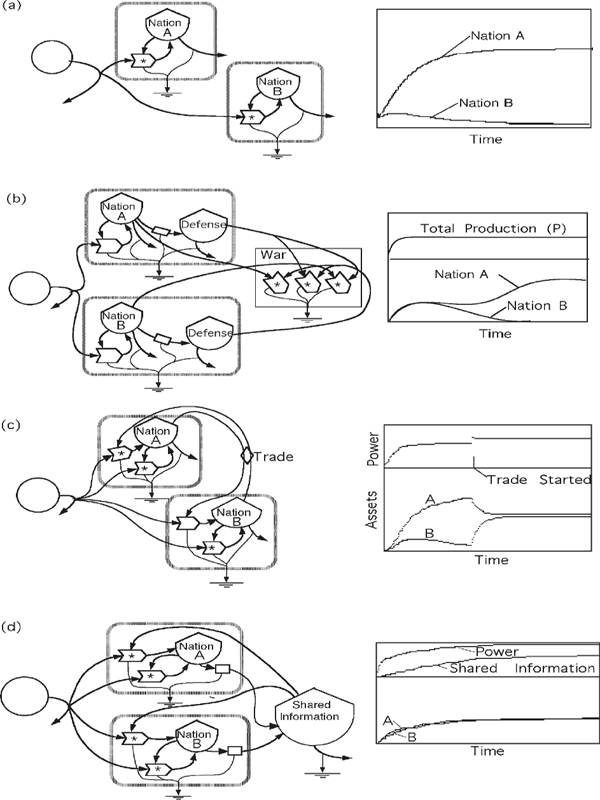
FIGURE 10.12 Energy systems minimodels of national relationships and typical computer simulations. (a) Simple competition for resources; (b) active competition of war; (c) action of trade in making competitors cooperative; (d) national cooperation through the sharing of information. Equations for the simulation of national relationships are as follows:
(a) Nations with simple competition for resources:
Available energy: R = I – (k1 * R * A)– (k2 * R * B);
R = I/[1 + (k1 * A) + (k2 * B)].
Population Q1: dA/dt = (k5* R* A) – (k3* A).
Population Q2: dB/dt = (k6 * R * B) – (k4 * B).
(b) Nations at war:
Resources: R = I – (k0 * R * A) – (k1 * R * B);
R = I/[1 + (k0* A) + (k1 * B)].
Assets: dA/dt = (k2 * R * A) – (k3 * A) – (k6 * A) – (k13 * A * Mb);
dB/dt = (k4 * R * B) – (k5 * B) – (k9 * B)– (k12 * B * Ma).
Defense: dMa/dt = (k7 * A) – (k8 * Ma) – (k16 * Ma * B) – (k15 * Ma * Mb);
dMb/dt = (k10 * B) – (k11 * Mb) – (k14 * Mb * A) – (k17 * Ma * Mb).
(c) Trading relationship:
Resources: R = I – (k1 * R * B) – (k18 * R * B) – (k19 * R * A) – (k0 * R * A);
R = I/[1 + (k1 * B) + (k18 * B) + (k19 * A) + (k0 * R)].
Assets A: dA/dt = (k2 * R * A) + (k20 * R * B) – (k3 * A);
dB/dt = (k4 * R * B) + (k21 * R * A) – (k5 * B).
(d) Nations sharing information:
Resources available: R = I – (k0 * R * A) – (k1 * R * B) – (k13 * R * S) – (k14 * R * S);
R = I/[1 + (k0 * A) + (k1 * B) + (k13 * S) + (k14 * S)].
Assets, A and B: dA/dt = (k11 * R * S) + (k2 * R * A) – (k3 * A);
dB/dt = (k4 * R * B) + (k12 * R * S) – (k5 * B).
Shared information S: dS/dt = (k6 * A) + (k7 * B) – (k9 * R * S) – (k10 * R * S) – (k8 * S).
Total power P: P = (k2 * R * A) + (k11 * R * S) + (k4 * R * B) + (k12 * R * S).
An Emergy Basis for International Organization
When the emergy flow to human groups was small, boundaries resulted from testing of the power to defend. Developing territories according to the emergy available is analogous to birds defending territories. These mechanisms kept populations distributed in proportion to resources. Now, however, countries have enormous empower budgets. Even ritualistic empower testing by military defenses at boundaries is too wasteful and could be replaced by agreements to use empower evaluation.
The world evolved international organizations to maintain peace, but organizations such as the League of Nations after World War I were soon bypassed when their real empower did not correspond to their votes. Currently in the United Nations General Assembly the votes by countries with small energy budgets are equal to the votes of countries with vast energy budgets. As a result, some international disputes have moved outside the United Nations. This degrades the organization’s potential might to that of a paper tiger. In order for votes to anticipate and make unnecessary the wielding of economic and military power, voting could be adjusted to correspond to annual empower.
The power budget of a country is readily computed (table 10.1) and could be determined annually. Instead of the yearly assignment of votes in proportion to the number of nations, they could be assigned in proportion to each country’s emergy budget of the previous year. Thus, the voting power would always correspond to the country’s real ability to influence the world. Because economic power and military power stem from empower, these influences would then correspond to the vote in the world organization. A voting demonstration of power could substitute for the vast expense of a direct economic or military test. Any majority vote would be backed automatically by an empower excess, which might be a deterrent.
The use of empower as the means of allocating votes has more flexibility than votes fixed by an organizational charter. An undeveloped country that increases its power budget with industrialization gains votes in proportion. The empower budget includes all kinds of energy. The process of annually computing votes from power budgets for everyone to see also eliminates posturing, apprehensions, propaganda, and saber rattling about strength. True empower becomes known as it develops without military and economic demonstrations. Perhaps empower voting can eliminate wars of miscalculation.
Organization by Global Information Sharing
What is most exciting is the global sharing of information that was already predominant in the year 2002. Although agents of capitalism seek to restrict information as a sales commodity, large-scale shared information, such as common genetic varieties for agriculture and common attitudes toward peace and global pluralism, reinforce all countries, making them coexist. The model in fig. 10.12d generates coexistence and greater global empower. The important question is whether enough global attitude sharing can exist in times of lower energy to preserve a system of peaceful cooperation. Or will the system of defended boundaries return?
Preservation of Cultures
In low-energy times many cultures provided a stable existence for their people, but over the past two centuries, low-energy systems have been gradually invaded with the ways of the empower rich. Low-emergy budget systems ultimately are displaced by systems that involve more empower. However, an energy-rich system can preserve some of the simpler culture. Many countries set aside native reservations, but most of the youth on the reservations seek higher-emergy ways. But some proud people of older cultures are preserving language, rituals, and symbols as an avocation, for visitors, for group cohesion, and for historical education. Some older ways, persisting in cultural memory, may be needed again when times of lower energy return.
Pluralism and the Global Organization of Society
Just as species of large territory and influence tend to stabilize global ecosystems, units of society are evolving with global territory and influence. Religious differences decrease as migration causes all countries to contain some of all religions. Some global corporations may be evolving away from emphasis on profit for growth toward a mode of service for survival. Many nongovernment organizations try to protect diversity of life and learning. The United Nations has gradually expanded its role from health, welfare, and information to forceful peacekeeping. Religious institutions may be evolving a new role (see chapter 11).
As said before, the higher information resides in the energy hierarchy, the more emergy it requires. Shared ideals on a global scale have great impact, but the quantity of information that can be transformed, distributed, and absorbed on that scale is emergy limited. In other words, it is not desirable, nor is there enough emergy to homogenize information sharing to make one global culture. Besides, diversity of culture, like the diversity of occupations and species, helps maximize function. Thus energy hierarchy principles support global pluralism, in which there is diversity of lifestyles and functions on smaller scales while at the global level a unified concept of respect for differences, international equity, and unity with nature is shared.
SUMMARY
Energy principles explain the growth of world populations and the designs by which people are self-organized into social relationships and institutions. In their lifetimes, human beings pass through an energy hierarchy of increasing transformity and influence. Human societies alternate between a stage of overgrowth when there are excess resources that cause simple conformity and a complex stage of high emergy, diversity, and information. Among nations, competition and war prevail when there is growth in emergy use. When resources are not in excess, nations develop mechanisms of cooperation and peace, including trade and information sharing. The climax states with excess emergy have high-transformity symbols such as dragons, sports, military shows, and social causes to focus national attention on the system. When group visions for a better system go unrealized, these high-empower pathways can short circuit through destructive social eddies. The emergy of organization and diversity increases with the numbers of types and their connections. The successful organization of people into a society has positive empower reinforcement loops, which keep the governing controls adapted for maximum performance.
BIBLIOGRAPHY
Note: An asterisk denotes additional reading.
Allee, W. C. 1938, 1951. Cooperation Among Animals. New York: Henry-Schuman.
Altman, D. E. and L. Levitt. (2002, January 23). The sad history of health care cost containment as told in one chart. Health Affairs, Web exclusive. Retrieved April 1, 2002, from http://healthaffairs.org/1110_web_exclusives.php.
Ardrey, R. 1966. The Territorial Imperative. New York: Atheneum.
Berne, E. 1964. Games People Play. New York: Grove Press.
Brown, M. T. 1977. Ordering and disordering in South Vietnam by energy calculations. In H. T. Odum, M. Sell, M. Brown, J. Zucchetto, C. Swallows, J. Browder, T. Ahlstrom, and L. Peterson, The Effects of Herbicides in South Vietnam, Part B: Working Papers. Models of Herbicide, Mangroves and War in Vietnam, 165–191. Washington, DC: National Academy of Sciences.
Cartwright, D. 1959. Studies in Social Power. Ann Arbor: University of Michigan.
Clark, P. J., P. T. Eckstrom, and L. C. Linden. 1964. On the number of individuals per occupation in a human society. Ecology 45: 367–372.
Easton, D. 1965. A Systems Analysis of Political Life. New York: Wiley.
Edmondson, W. T. 1965. Reproductive rate of planktonic rotifers as related to food and temperature in nature. Ecological Monographs, 35: 61–111.
French, J. R. P. 1956. A formal theory of social power. Psychological Review, 63: 181–194.
Gibbon, E. 1962. Barbarism and the Fall of Rome. Vol. II of the History of the Decline and Fall of the Roman Empire, 1776, 1778, abridged and edited by J. Sloan. New York: Collier.
Henderson, K. 1977. Senility and mortality. Master’s paper, University of Florida, Gainesville.
Hoebel, E. A. 1961. The Law of Primitive Man. Cambridge, MA: Harvard University Press.
Kowallik, W. 1967. Chlorophyll-independent photochemistry in algae. In Energy Conversion by the Photosynthetic Apparatus, 467–477. Brookhaven Symposia in Biology, No. 19. Upton, NY: Brookhaven National Laboratory.
*Kroeber, A. L. 1963. An Anthropologist Looks at History. Berkeley: University of California Press.
*Lack, D. 1954. The Natural Regulation of Animal Numbers. Oxford, UK: Clarendon.
Lasswell, H. D. and A. Kaplan. 1950. Power and Society. New Haven, CT: Yale University Press.
Logan, M. O. 1998. A Simulation Model of the System of Health Care in the United States. Ph.D. dissertation, George Mason University, Fairfax, VA.
McClanahan, T. R. 1990. Hierarchical Control of Coral Reef Ecosystems. Ph.D. dissertation, University of Florida, Gainesville.
Nixon, S. 1969. Characteristics of Some Hypersaline Ecosystems. Ph.D. dissertation, University of North Carolina, Chapel Hill.
Odum, H. T. 1983. Systems Ecology. New York: Wiley.
——. 1996. Environmental Accounting, Emergy and Decision Making. New York: Wiley.
——. 1999. Limits of information and biodiversity. In H. Loeffler and E. W. Streissler, eds., Sozialpolitik und Okologieprobleme der Zukunft, 229–269. Vienna: Austrian Academy of Science.
Odum, H. T., S. Nixon, and L. DiSalvo. 1971. Characteristics of photoregenerate systems. In J. Cairns, ed., The Structure and Function of Freshwater Microbial Communities, 1–29. Blacksburg: American Microbiology Society, Virginia Polytechnic University.
Odum, H. T. and D. M. Scienceman. 1986. Commonalities between hierarchies of ecosystems and political institutions. Yearbook of the International Society for the Systems Sciences, 29: 23–32.
Slobodkin, L. B. and S. Richman. 1965. The effect of removal of fixed percentages of the new born on size and variability in populations of Daphnia pulicaria (Forbes). Limnology and Oceanography, 1(3): 209–237.
Stoekenius, W. 1978. Bioenergetic mechanisms in Halobacteria. In S. R. Caplan and M. Ginsburg, eds., Energetics and Structure of Halophile Microorganisms, 185–198. North Holland: Elsevier.
Strehler, B. L. and A. S. Mildvan. 1960. General theory of mortality and aging: A stochastic model relates observations on aging, physiologic decline, mortality, and radiation. Science, 132: 14–21.
Sundberg, U., J. Lindegren, H. T. Odum, and S. Doherty. 1994. Forest emergy basis for Swedish power in the 17th century. Scandinavian Journal of Forest Research, Supplement No. 1.
Toynbee, A. 1935–1939. A Study in History, Vols. 1–6. London: Oxford University Press.
Von Foerster, H., P. M. Mora, and L. W. Amiot. 1960. Doomsday: Friday 13 Nov. A.D. 2026. Science, 132: 1291–1295.
Woithe, R. 1994. Emergy Evaluation of the United States Civil War. Ph.D. dissertation, University of Florida, Gainesville.
Wynne-Edwards, V. C. 1962. Animal Dispersion in Relation to Social Behavior. New York: Hafner.
NOTES
1. Malthus was a demographer and political economist in England who wrote an important essay in 1798 on population growth titled “An Essay on the Principle of Population, as It Affects the Future Improvement of Society with Remarks on the Speculations of Mr. Godwin, M. Condorcet, and Other Writers.” Malthus’s pessimistic views on the human struggle for existence influenced Charles Darwin and his theory of evolution.
2. This section was written by Mary Odum Logan and gives the results of an energy systems analysis of health care in the United States, which she performed with advice from her father.
3. Strehler and Mildvan (1960) used the biomathematics of death curves with time to show that human death often may be caused by the chance that the energy demands of random stresses exceed reserves as the efficiency of functions decline with senescence. They showed how to derive the Gompertz equation from this premise. Human death curves follow the Gompertz graph from age 30 to 75. A Gompertz curve is straight on a log–log graph with time. Kevin Henderson (1977) improved the fit of the Gompertz function to human survivorship curves by modifying the relationship with a negative exponential term to account for infant mortality and demonstrating the new mortality function with analog computer simulation (Odum 1983).
4. The form of feedbacks is that of political institutions given by Easton (1965) but here recognized as pathways of high emergy and transformity.
5. A diagram with these pathways was given in Environment, Power, and Society.
6. Ecological studies of diurnal changes in oxygen in brine microcosms by Scott Nixon (1969) (see fig. 12.9) showed the role of rhodopsin before its mechanisms were worked out physiologically (Odum et al. 1971; Stoekenius 1978).
7. A mechanism to represent the essence of learning with an energy systems diagram includes a sensor from an operating pathway storing information in a tank symbol that autocatalytically reinforces further flow in that pathway.
8. Emergy evaluations were made of the Vietnam War (Brown 1977), the U.S. Civil War (Woithe 1994), and the Swedish wars of the 17th century (Sundberg et al. 1994). Using numbers from newspaper clippings, the author presented an emergy evaluation of the Persian Gulf War and its oil well fires to the American Association for the Advancement of Science meeting in Chicago (1998). The emergy used and destroyed in the war exceeded the Near East oil budgets for that year but was much less than the Near East oil reserves.